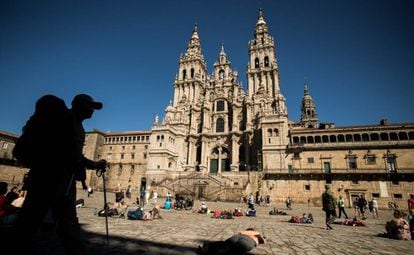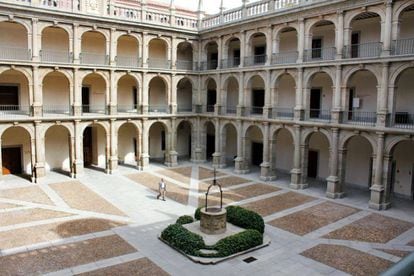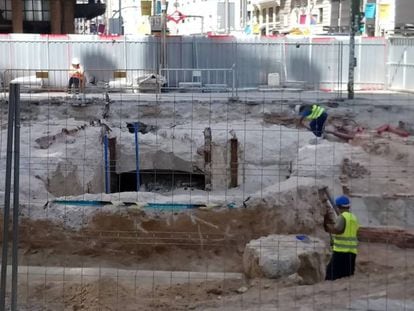Burden or blessing? Spain’s World Heritage Sites struggle to maintain costly UNESCO status
Protecting their distinction while managing basic services is proving difficult for 15 Spanish cities, which are demanding extra funding


A little more than a year ago, a delivery truck ran over the handrail on the famous Bajada de Misericordia street in Tarragona in Catalonia. The City Hall has still not fixed it. Not because it doesn’t want to but because “a special project” must first be implemented to restore it if the Catalan city wants to remain a World Heritage Site, a status it was granted by UNESCO in November 2000.
The cities say they need support to compensate for the loss in revenue, given that protected sites are exempt from paying property tax
In Úbeda, a town in Jaén in Spain’s southern Andalusia region, streets in the historic center are swept by hand because street cleaners are not allowed in the protected site. And in San Cristóbal de la Laguna, on the Canary Island of Tenerife, there are not enough cellphone antennas because they damage the image of the World Heritage Site.
“The distinction multiplies expenses but not municipal income,” says Javier Rodríguez Palacios, the mayor of Alcalá de Henares in the Madrid region, which has a UNESCO-listed university and historical center. “We are very proud to be chosen but we need help from the state.”
The 15 cities in Spain that belong to the Organization of World Heritage Cities because they are home to UNESCO-listed sites have come together to demand greater funding. They say financial support is needed from the government or the European Union to compensate for the loss in tax revenue, given that protected sites are exempt from paying property tax (known in Spanish as IBI) – a city hall’s main source of revenue – as well as constructions, facilities and building works tax (known as ICO).

If a city hall fails to maintain its protected site, it can be stripped of the special status, says Palacios. This happened to Dresden in Germany after a bridge was built in a protected area.
“These are living cities and we have to continue maintaining them,” he explains. “The difference between a Heritage City and a Heritage Site is that sites only have one or a few buildings, like the monastery in San Lorenzo de El Escorial [in the Madrid region]. It’s closed from 8pm until the next day. There are no extra expenses for security. In Alcalá, in contrast, you have to be on watch at all hours.”
Begoña Floria, the deputy mayor of Tarragona, is calling for an increase in sponsorship and business donations through corporate social-responsibility policies. “Now that the financial crisis is over, it is time to invest in culture,” she says.
The main problem is we are not a museum Mayor of San Cristóbal de La Laguna, José Alberto Díaz
“Putting an elevator in a town hall and discovering a Roman Circus in the ground below is not the same as putting in an elevator in a modern building on the outskirts of the city. The archaeological proceedings and studies take time and the costs go through the roof,” Floria explains.
According to José Luis Rivas, the mayor of the Castile and León city of Ávila, which was declared a World Heritage City in 1985, “the distinction brings a lot of good things but it is true that the City Hall treasury resents it.” Rivas says he tries to increase revenue with “cultural activities” aimed at tempting tourists to spend the night in the city.
Lola Marín, the mayor of Baeza in Andalusia, which was named a World Heritage City in 2003, agrees that spending has risen because of the recognition. “We are lucky because tourism has increased but costs have also increased by 10%. We have created tourist police and we clean the streets by hand because street cleaners cannot enter the protected area,” she explains.
We are lucky because tourism has increased but costs have also increased by 10%
Mayor of Baeza Lola Marín
In Tenerife in San Cristóbal de La Laguna, the UNESCO status has caused other issues. Communication is a challenge because cables and antennas are not allowed to be visible. José Alberto Díaz, the mayor of the town, says “the main problem is the fact that we are not a museum. You have to let cars park in garages, children go to school, for everything to be accessible to everyone, but without losing the historical essence. You have to have fiber optic cabling but the infrastructure can’t be seen.”
What’s more “because the neighborhoods are attractive, the cost of housing rises and homes are taken over by businesses,” he says. “The energy costs are enormous because lots of people choose the center to hold cultural events or nighttime activities …. How are you going to say no? In the end, you have to pay up.”
English version by Melissa Kitson.












































